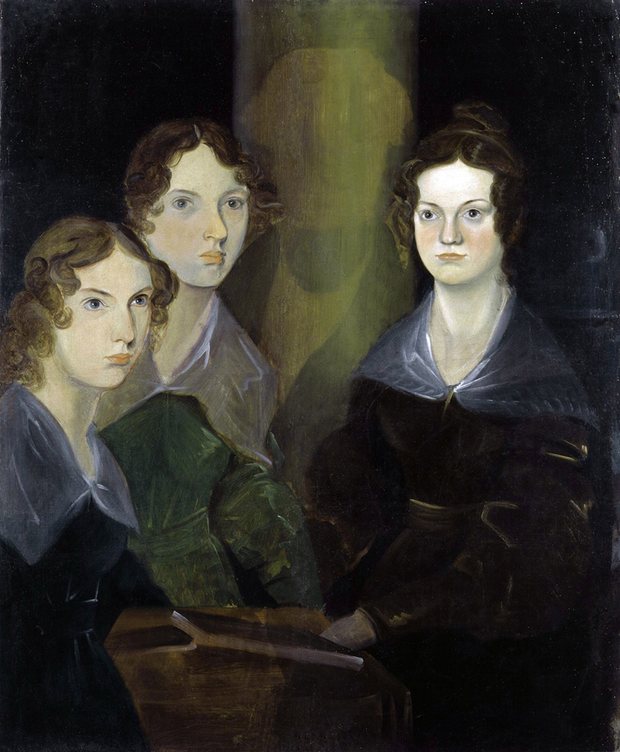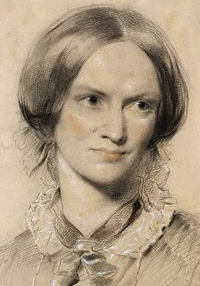JANE EYRE’s author

———————
A brief biography of Charlotte Brontë–by Lydia Ramsour
Charlotte was born in Thornton, Yorkshire on April 21, 1816. Her mother, Maria, and father, Patrick, had six children–five girls and one boy. Patrick was an Anglican clergyman at St. Michael and All Angels church in Haworth, Yorkshire. Maria died of cancer on September 15, 1821, leaving the six children with their father to be cared for by the oldest sister, Elizabeth.

In 1824, their father sent the four oldest sisters to the Clergy Daughters School in Lancashire. The school’s conditions affected Charlotte’s health and likely lead to the deaths of her sisters, Marie and Elizabeth, of tuberculosis in 1825. Patrick Brontë brought Charlotte and Emily home after the death of their sisters. Upon returning home, Charlotte acted as a mother to her younger siblings, Emily, Anne and Bramwell; she wrote and acted out imaginary stories with them. In 1829 she began writing stories. Between 1831 and 1832 Charlotte went to Roe Head School, where she met her forever friends, Ellen Nussey and Mary Taylor. She later went back to teach at Roe Head for a short time. In 1839, at age 23, she became a governess in Yorkshire.
Governess work seems to have been uncongenial to her, as all her positions were short-lived. A school which she and her sisters planned to open never materialized. After long preparation they advertised but failed to secure a single pupil.
Then Charlotte hit on the idea of publishing their writings. This venture was more successful: in 1846 a volume of their collected poems appeared, under the pseudonyms Currer, Ellis and Acton Bell. However Charlotte’s first novel, The Professor, was rejected. When asked why they used aliases she said,
“Averse to personal publicity, we veiled our own names under those of Currer, Ellis and Acton Bell; the ambiguous choice being dictated by a sort of conscientious scruple at assuming Christian names positively masculine, while we did not like to declare ourselves women, because — without at that time suspecting that our mode of writing and thinking was not what is called “feminine” – we had a vague impression that authoresses are liable to be looked on with prejudice; we had noticed how critics sometimes use for their chastisement the weapon of personality, and for their reward, a flattery, which is not true praise.”
In August that year she began writing Jane Eyre, which was published in October 1847. Emily’s Wuthering Heights and Anne’s Agnes Gray were published the same year (all three women were still using the Bell pseudonyms). Jane Eyre quickly became a bestseller. 1849 Charlotte’s novel, Shirley, was published in 1849, and Villette in 1853.
Sadly, Bramwell was a drug addict and alcoholic by this time, and he died in 1848. Emily also died that year, of pulmonary tuberculosis, and Anne died the following year of the same disease.

Charlotte married Arthur Bell Nicholls, the curate of Haworth, in June 1854, though it does not appear that she was in love with him. She became pregnant soon after their wedding and her poor health continued to worsen. Charlotte died of pneumonia while carrying her unborn child in the spring of 1855 just a few weeks short of her 39th birthday. Charlotte Brontë’s life reflected that of her famous book and character Jane Eyre. Elizabeth Gaskell’s biography of her, The Life of Charlotte Brontë, was published in 1857–a significant achievement for a female author at that time.
Source material:
https://en.wikipedia.org/wiki/Charlotte_Bront%C3%AB
http://www.haworth-village.org.uk/brontes/charlotte/charlotte.asp
http://www.victorianweb.org/authors/bronte/cbronte/brontbio.html
